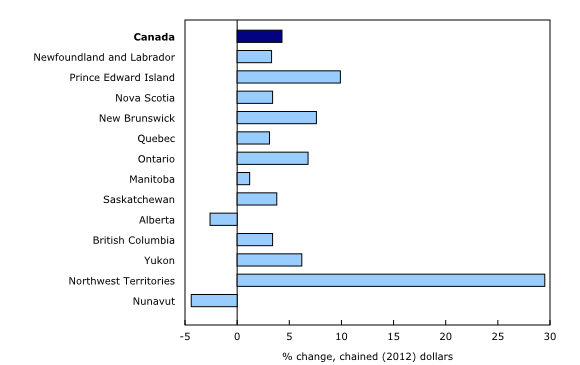Provincial and territorial economic accounts, 2020
Archived Content
Information identified as archived is provided for reference, research or recordkeeping purposes. It is not subject to the Government of Canada Web Standards and has not been altered or updated since it was archived. Please "contact us" to request a format other than those available.
Released: 2021-11-09
In 2020, real gross domestic product (GDP) fell in all provinces and in the Northwest Territories. Canada's real GDP was down 5.2%, the sharpest annual decline since 1961, the year data were first recorded.
The drop in economic activity reflected widespread COVID-19-related restrictions imposed on consumers and businesses and reductions in exports, as major trading partners faced similar restrictions.
The scope, duration, and impact of mandatory shutdowns and supply chain disruptions varied by region. Most regions saw sharp declines in household spending, exports, and business investments in non-residential structures, machinery and equipment, and intellectual property products. To some extent, the general downturn was mitigated by fewer imports and by increases in general government investments and investments in housing.
Rising housing investment
The ability to work from home, alongside savings from less travel and less participation in other activities, combined with low mortgage rates, boosted new home construction, renovations, and resales in 2020.
In 2020, growth in housing investment was strongest in Prince Edward Island (+9.9%), followed by New Brunswick (+7.6%), Ontario (+6.8%), and the Northwest Territories (+29.5%). Meanwhile, housing investment fell in Alberta (-2.6%) and Nunavut (-4.4%).
Higher household saving rate
Declines in wages and salaries (-1.2%) were softened by government COVID-19 support measures to households, such as the Canada Emergency Response Benefit, the Canada Emergency Student Benefit, and the one-time increase in the Canada Child Benefit payment in May 2020.
Household spending fell (-5.6% in nominal terms), reflecting restrictions on opportunities to spend on travel, tourism, restaurants, and sports- and entertainment-related products. The household saving rate rose to 14.8%, the highest since 1985. Saving rates were particularly high in Quebec, Ontario, and each territory. At 5.6%, Newfoundland and Labrador had the lowest rate.
Note to readers
This release incorporates revisions to the Provincial and Territorial Economic Accounts for 2018 and 2019, and estimates for 2020. Estimates of provincial–territorial gross domestic product (GDP) by industry from 2018 to 2020 were also revised. Both incorporate 2018 benchmark provincial and territorial supply and use tables, as well as revisions to the national income and expenditure accounts.
This release also incorporates T4 benchmark data for 2019 and preliminary estimates for 2020, and revised source data from surveys including the Retail Commodity Survey, the International Trade in Services Survey, and the Annual Capital and Repair Expenditures Survey for 2019.
Canada totals in the provincial and territorial GDP by income and by expenditure accounts do not correspond to the national GDP by income and by expenditure accounts estimates at certain times of the year. The two accounts will be brought back in line when annual revisions are incorporated with the third quarter release on November 30, 2021.
Percentage changes for expenditure-based statistics (such as household spending, exports and imports) are calculated from volume measures adjusted for price variations.
For more information on GDP, see the video "What is Gross Domestic Product (GDP)?"
Support measures by governments
To alleviate the economic impact of the COVID-19 pandemic, governments implemented several programs, including the Canada Emergency Wage Subsidy, the Canada Emergency Rent Subsidy and the Canada Recovery Benefit. For a comprehensive explanation of how government support measures were treated in the compilation of the estimates, see "Recording COVID-19 measures in the national accounts" and "Recording new COVID measures in the national accounts."
Details of some of the more significant government measures can be found in the table Federal government expenditures on COVID-19 response measures.
Products
Provincial and territorial gross domestic product by income and expenditure accounts
Provincial and territorial gross domestic product (GDP) by income and expenditure accounts includes estimates of income- and expenditure-based GDP, real GDP, contributions to percent change in real GDP, implicit price indexes, the current accounts for the household sector, the property income of households, and other selected indicators for the household sector.
The data visualization product "Provincial and territorial economic accounts: Interactive tool," which is part of Statistics Canada—Data Visualization Products (71-607-X), is now available.
The Latest Developments in the Canadian Economic Accounts (13-605-X) is available.
The User Guide: Canadian System of Macroeconomic Accounts (13-606-G) is available.
The Methodological Guide: Canadian System of Macroeconomic Accounts (13-607-X) is available.
Gross domestic product by industry – Provincial and territorial (annual)
Revised figures for 2018 to 2020 provincial and territorial GDP by industry are included with this release.
The data visualization product "Gross domestic product (GDP) by industry, provinces and territories: Interactive tool" was also revised for the 2018 to 2020 period. This tool makes it easier for users to consult GDP data as part of Statistics Canada's corporate vision to make data more accessible in useful ways.
Contact information
For more information, or to enquire about the concepts, methods or data quality of this release, contact us (toll-free 1-800-263-1136; 514-283-8300; STATCAN.infostats-infostats.STATCAN@canada.ca) or Media Relations (613-951-4636; STATCAN.mediahotline-ligneinfomedias.STATCAN@canada.ca).
- Date modified:






